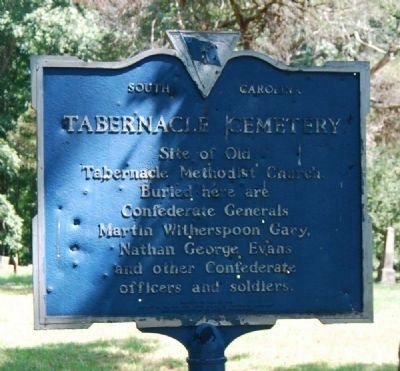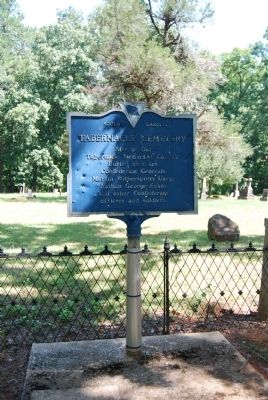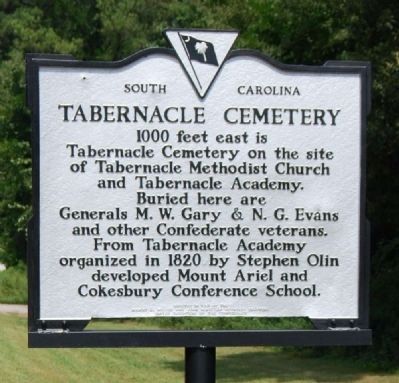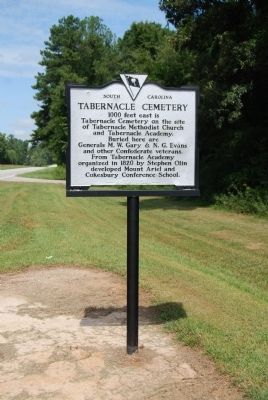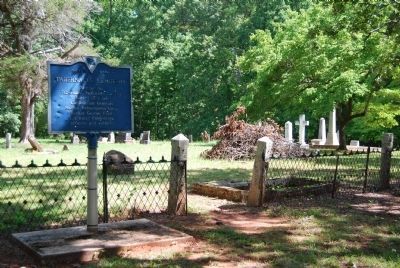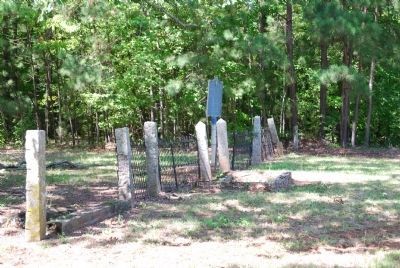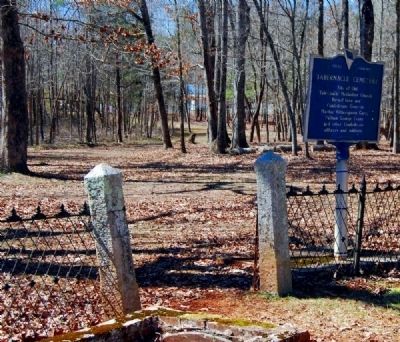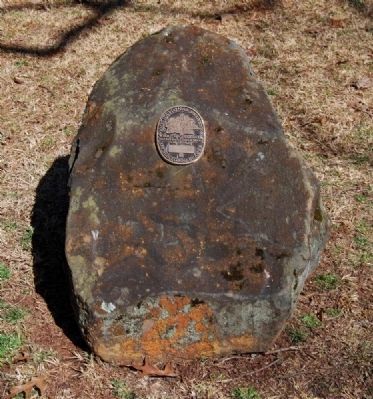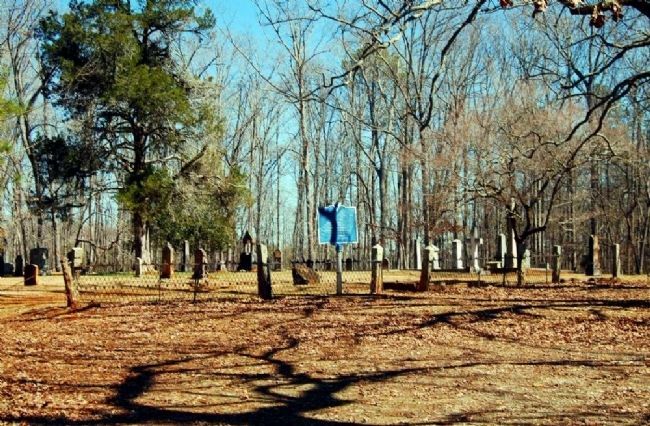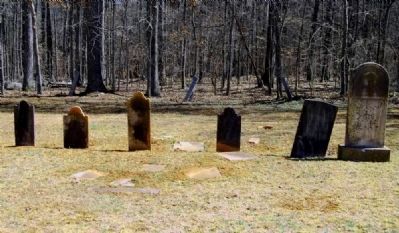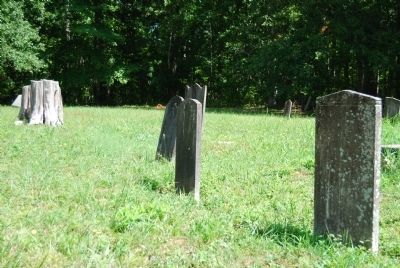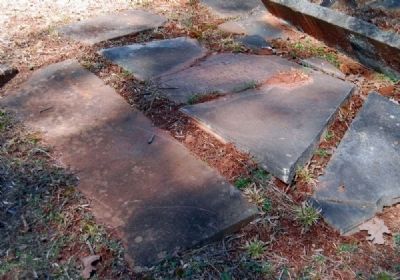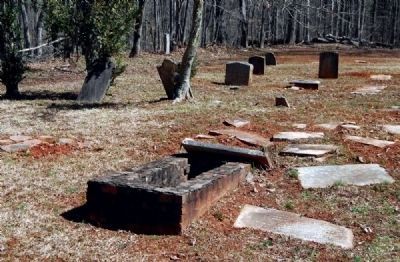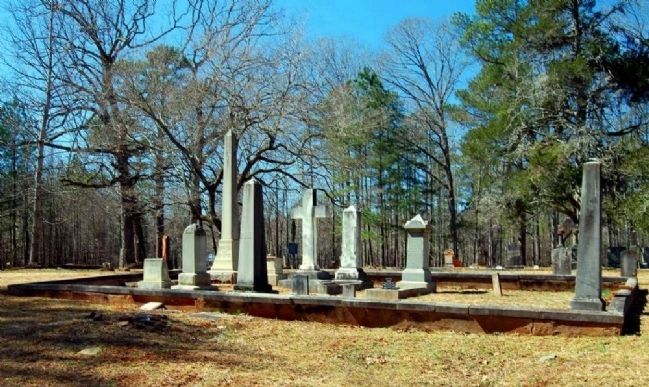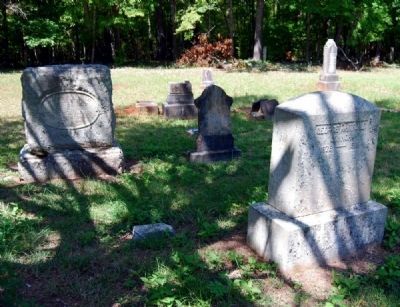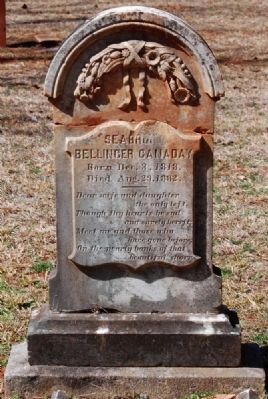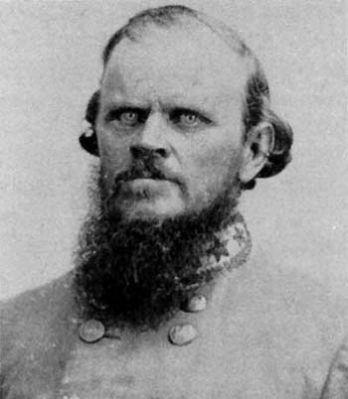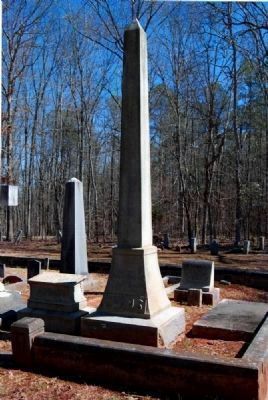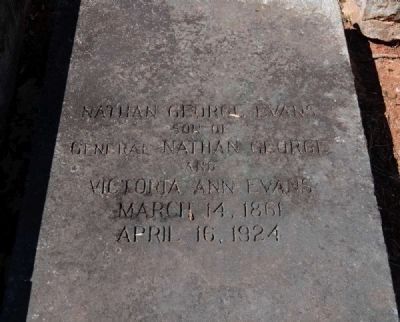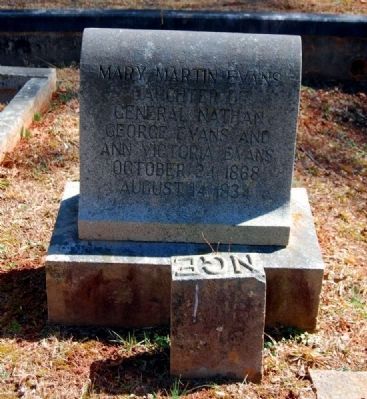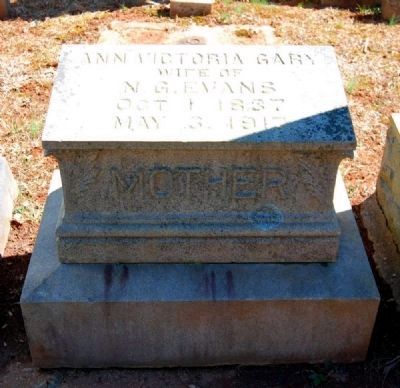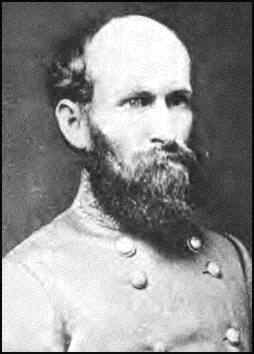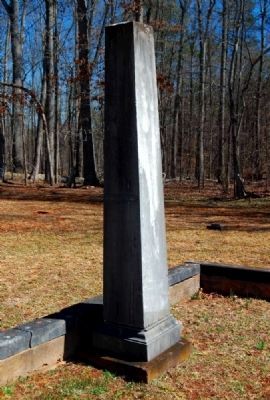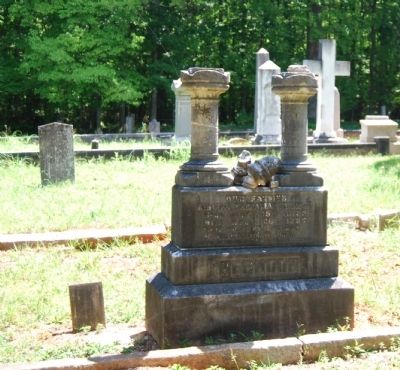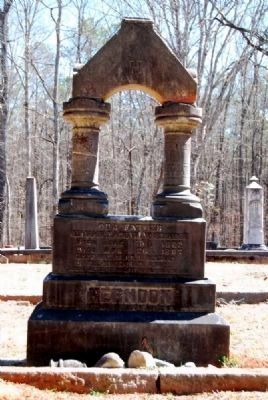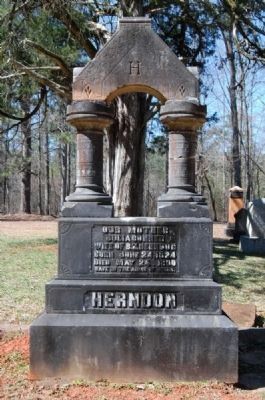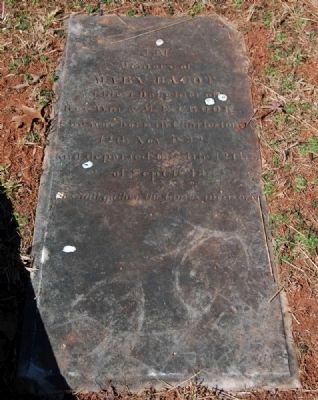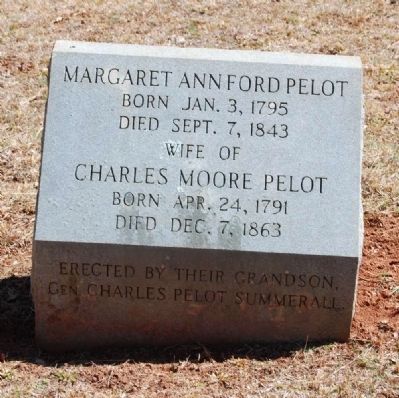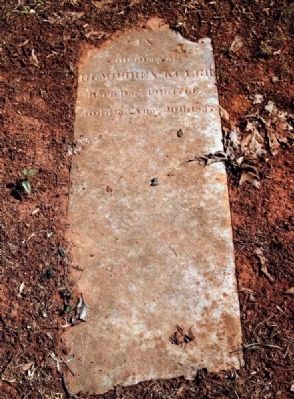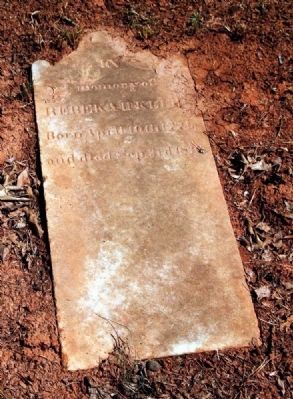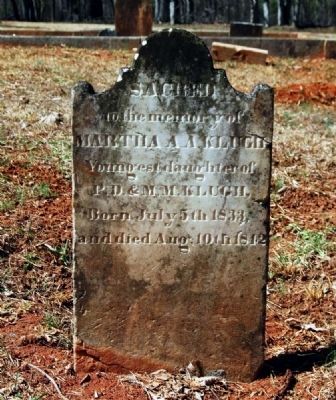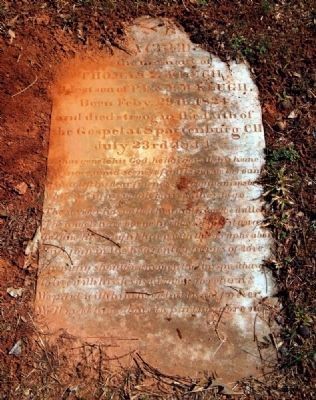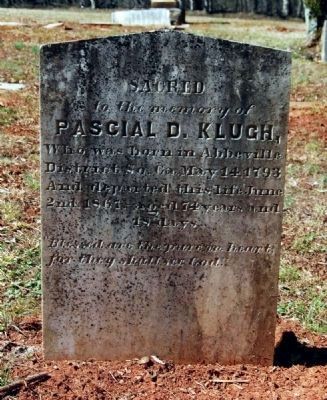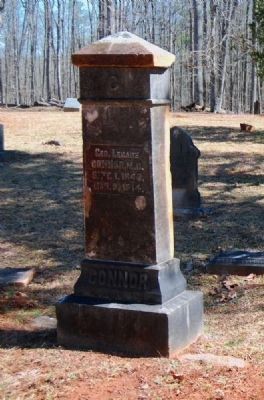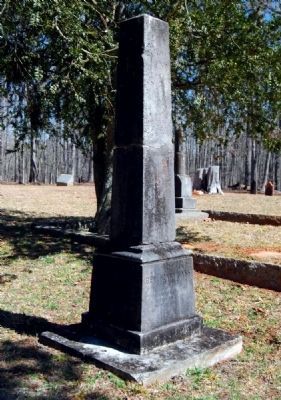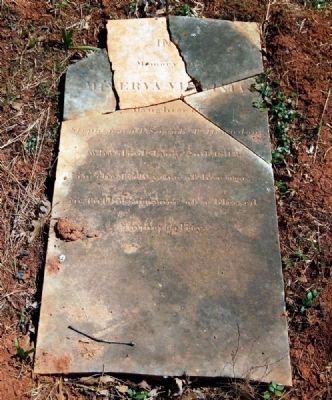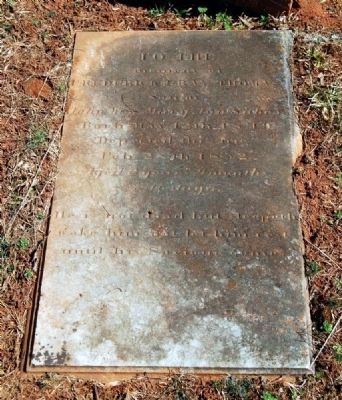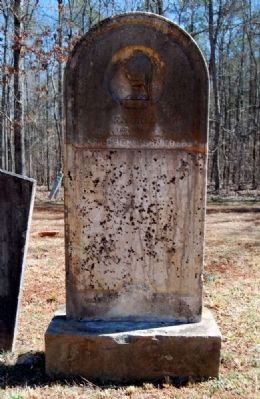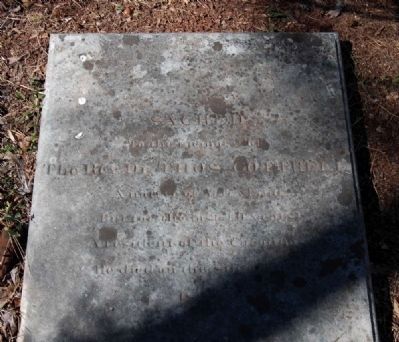Hodges in Greenwood County, South Carolina — The American South (South Atlantic)
Tabernacle Cemetery
[Original Marker]
Site of Old Tabernacle Methodist Church. Buried here are Confederate Generals Martin Witherspoon Gary, Nathan George Evans and other Confederate officers and soldiers.
[Second Marker]
1000 feet east is Tabernacle Cemetery on the site of Tabernacle Methodist Church and Tabernacle Academy. Buried here are Generals M.W. Gary & N.G. Evans and other Confederate veterans. From Tabernacle Academy organized in 1820 by Stephen Olin developed Mount Ariel and Cokesbury Conference School.
Erected by Robert A Walker and John McKellan Reynolds Chapters, United Daughters of the Confederacy. (Marker Number 24-5.)
Topics and series. This historical marker is listed in these topic lists: Cemeteries & Burial Sites • Churches & Religion • Education • War, US Civil. In addition, it is included in the United Daughters of the Confederacy series list.
Location. 34° 15.98′ N, 82° 11.252′ W. Marker is in Hodges, South Carolina, in Greenwood County. Marker is on Cokesbury Road (State Highway 254), on the left when traveling east. North of the marker is a short paved area. This is the start of Tabernacle Cemetery Road. The "road" follows the tree line south and enters the woods behind the business on Cokesbury Road. Once you enter the woods, the cemetery will come into view. Touch for map. Marker is in this post office area: Greenwood SC 29649, United States of America. Touch for directions.
Other nearby markers. At least 10 other markers are within 6 miles of this marker, measured as the crow flies. Park’s / Greenwood County (approx. 0.6 miles away); Payne Institute (approx. 2.1 miles away); Old Cokesbury and Masonic Female College and Conference School (approx. 2.2 miles away); Moorefield Memorial Highway (approx. 3.6 miles away); In Memorium (approx. 4.9 miles away); Rock Presbyterian Church (approx. 5.1 miles away); Lynching in America / The Phoenix Massacre (approx. 5.2 miles away); Gleamns (approx. 5.2 miles away); Dr. Benjamin Elijah Mays (approx. 5.2 miles away); Francis Salvador (approx. 5.2 miles away). Touch for a list and map of all markers in Hodges.
Also see . . .
1. Tabernacle Cemetery. Tabernacle Cemetery, established ca. 1812, is significant as an early cemetery in the Tabernacle community of what was then Abbeville District, and for its association with many prominent citizens of Abbeville and Edgefield Districts and later Greenwood County as well, from the early nineteenth through the twentieth centuries. (Submitted on September 6, 2008, by Brian Scott of Anderson, South Carolina.)
2. Find a Grave: Tabernacle Cemetery. Find a Grave entry. (Submitted on April 10, 2010, by Brian Scott of Anderson, South Carolina.)
3. A Night Visit to Tabernacle Cemetery (YouTube). The cemetery was spooky in the day, isolated and quiet, even with the sun shining and my car in site. This video shows what it looks like at night. (Submitted on September 6, 2008, by Brian Scott of Anderson, South Carolina.)
4. Martin Witherspoon Gary. Martin Witherspoon Gary (March 25, 1831 – April 9, 1881) was a brigadier general in the Confederate States Army during the American Civil War and a Democratic politician in postbellum South Carolina. (Submitted on April 9, 2010, by Brian Scott of Anderson, South Carolina.)
5. Nathan George Evans. Nathan George "Shanks" Evans (February 3, 1824 – November 23, 1868) was a captain in the 2nd U.S. Cavalry who became a brigadier general in the Confederate States Army during the American Civil War. (Submitted on April 10, 2010, by Brian Scott of Anderson, South Carolina.)
Additional commentary.
1. Tabernacle Cemetery
Tabernacle Cemetery, sometimes called Old Tabernacle Cemetery, is located on Tabernacle Cemetery Road, just east of S.C. Highway 254 (Cokesbury Road), approximately 1 mile northwest of Greenwood and approximately 2 miles southeast of Cokesbury, in Greenwood County, S.C.
This early-nineteenth-to-early-twentieth century cemetery maintains a high degree of integrity of location, setting, design, materials and association. The cemetery is located on a 3.5 acre parcel. Approximately 1.03 of those acres is enclosed by a fence made from upright granite stones with wrought iron fencing between them. More recent graves are in evidence to the south and older graves are scattered among the trees in the open wooded area on the eastern edge of the Tabernacle plat. The wooded eastern area with scattered gravestones outside the fence is bordered by a ravine that leads to Coronaca Creek.
The cemetery contains approximately 132 marked graves, with headstones, footstones, and a few plot enclosures f granite, marble, fieldstone, or soapstone. Most gravestones are marble or granite tablets although obelisks and brick tombs are also present. The earliest marked graves are from the early 10th century, and most graves date from ca. 1812 to ca. 1950. The stones are arranged in most part by family units within the cemetery boundaries. They do show environmental wear and some minor vandalism but have been under the upkeep of the Olde Abbeville Camp #39 of the Sons of Confederate Veterans. The small scattering of graves located on the eastern edge of the plat outside of the fenced boundary among the trees is difficult to reach. The more modern graves directly south of the fenced boundary are located in a small clearing, clearly separate from the older markers. The 3/5 acres now held by the Greenwood County Historical Society covers all of the graves within and around the fenced area. The cemetery is entered through an opening created by granite posts. It contains little formal landscaping or plantings.
Significance
Tabernacle Cemetery, established ca. 1812, is significant as an early cemetery in the Tabernacle community of what was then Abbeville District, and for its association with many prominent citizens of Abbeville and Edgefield Districts and later Greenwood County as well, from the early 19th through the 20th centuries. It is also an excellent intact example of an early-19th through mid-20th century cemetery reflecting typical burial customers and gravestones of the period.
Additional Information
Tabernacle Cemetery is the only extant historical resource associated with the early Tabernacle community, established by Methodists in the old Abbeville District in the late 18th and early 19th centuries, including such institutions as the Tabernacle Meeting House (later Tabernacle Methodist Church), informally organized by 1788 but formally established on this site by 1812, and active hear until 1873, and the Tabernacle Academy, founded and built here in 1820-1821 and operating here until 1825.
George Conner (1759-1827) ad his
wife Anna Woolfolk Conner (1762-1825) owned the land that became the center of the Tabernacle community. The Conners came to South Carolina from Virginia and settled here shortly after the American Revolution. Most of the land on which the communities of Tabernacle, Cokesbury, and Mt. Ariel were later established was owned by George Conner.
Several Methodist families in the vicinity, who moved to this area from the town of Cambridge, or Old Ninety Six – approximately ten miles east – about the same time as the Connors, soon established a “Methodist society” by about 1788 or shortly thereafter and held occasional services.
Re. James Elizabeth Glenn (1786-1851), a Methodist minister and native of Virginia like George Connor, came to this area by 1812 and held regular services here, naming the society “Tabernacle.” Glenn oversaw the construction of the second permanent meeting house, a frame building constructed by slave labor ca. 1820-1821 which replaced the first log meeting house; it was described in 1860 as “a frame of ordinary dimensions, neither ceiled nor plastered.”
Glenn also encouraged the establishment and supervised the construction of the Tabernacle Academy, a successor school to Bishop Francis Asbury’s Bethel (or Mount Bethel) Academy, founded in 1793 in Newberry District. Glenn and the school
trustees – including George Connor – hired Stephen Olin (1797-1851), a native of Vermont and graduate of Middlebury College there, to be the first headmaster of the new Tabernacle Academy.
The Academy was described by Olin, Glenn, and its trustees in a 1822 appeal asking the South Carolina Conference of the Methodist Episcopal Church to be its patron, as “in operation during the last year and…still in successful progress. The[y] have erected a commodious building, in a healthy and pleasant situation, remote from scenes of intemperance and vice. The neighborhood is believed to be inferior to none in the state.” They closed by asking the Methodist establishment to support Tabernacle Academy’s “interest of piety and learning.” The South Carolina Conference soon took financial and administrative responsibility for the school, working with Olin, Glenn, and the trustees to ensure that it offered “the best advantages for the education of our children and the children of our people.” One historian of early 19th century Methodist schools in America later claimed, “Tabernacle Academy and its principal became known far and near. Students came from all parts of the South, eager to be pupils of so eminent and widely known a preceptor.”
Olin soon began preaching as well as teaching, and earned his license as a Methodist
minister in 1822. He left Tabernacle Academy in 1824 to become an itinerant preacher, but soon returned to education as his primary focus. His later career included service as a professor at the University of Georgia in Athens, as president of Randolph-Macon College in Lynchburg, Virginia, and finally as president of Wesleyan University in Connecticut, where he remained from 1831 until his death in 1851.
After Olin’s departure as principal of the Tabernacle Academy its trustees and other prominent citizens of the Tabernacle community began to consider the possibility of establishing a new town nearby, a “village” with regular lots laid out and sold to residents. They decided to call this new community – which they located two miles northwest – Mount Ariel. The town was planned in 1824-1825 and the first lots occupied and first post office opened in 1825. In 1834 Mount Ariel was renamed Cokesbury in honor of Reverends Thomas Coke and Francis Asbury, the first two Methodist bishops in the United States.
Te trustees of the Tabernacle Academy voted to relocate the school to Mount Ariel as well, later establishing separate male and female academies at Cokesbury. The old Tabernacle Academy on this side was occasionally used as a church until a new one was built in Cokesbury in 1837.
Old Cokesbury and Masonic Female College and Conference School, a rural historic district including the Cokesbury and Masonic Female College, later the Cokesbury Conference School (built 1854) as well as several houses built from 1840-1850, was listed in the National Register of Historic Places on August 25, 1970.
Tabernacle Methodist Church was an active Methodist congregation in the Cokesbury Circuit until about 1873; the church building was later dismantled, moved to Greenwood, and served as a parsonage for ministers in the Cokesbury Circuit.
The Tabernacle Cemetery continued to serve the citizens of Mount Ariel and Cokesbury communities well into the 20th century. In 1988, the trustees of Cokesbury United Methodist Church – the successor congregation to Tabernacle Methodist Church – transferred the 3.5-acre parcel to the South Carolina Conference of the United Methodist Church, which in turn transferred it to the Greenwood County Historical Society.
Among the prominent persons buried in Tabernacle Cemetery are:
Rev. Henry Bass (1786-1860), a Methodist minister; a native of Connecticut, who came to South Carolina and joined the South Carolina Conference of the Methodist Episcopal Church in 1812.
George Connor (1759-1827), a native of Caroline County, Virginia who came to this area after the American Revolution; planter and trustee of the Tabernacle Academy.
Lt. George Whitfield Connor (1832-1894), merchant and Confederate lieutenant in Company F, 2nd South Carolina Infantry, serving in the Army of Northern Virginia; Corp., Company F, 1861-1862; Sgt., 1862-1863; 2nd Lt., 1863-1865; wounded and captured at Chickamauga, Georgia, September 19 or 20, 1863, and later paroled; slightly wounded at Cold Harbor, Virginia, June 1, 1864; captured at Cedar Creek, Virginia, October 19, 1864; paroled at Fort Delaware, June 1865.
Rev. Thomas Cottrell (d. 1834), Episcopal minister and later a Methodist minister; a native of Virginia or Maryland, who was headmaster, along with his wife, of the girls’ school at Mount Ariel.
Rev. Samuel Dunwoody (1780-1854). Methodist minister; a native of Pennsylvania, who came to South Carolina and joined the South Carolina General Conference of the Methodist Episcopal Church in 1806; served as a delegate from the South Carolina Conference to the First General Conference of the Methodist Episcopal Church; author of A Sermon Upon the Subject of Slavery (1837), an early Biblical defense of the institution of slavery; second minister of Cokesbury Methodist Church, 1838-1839; retired to Cokesbury in 1846 and died there in 1854.
Brig. Gen, Nathan George Evans (1824-1868), United States and Confederate army officer; brother-in-law of John Hilary Gary and Martin Witherspoon Gary; attended Randolph-Macon College and the United States Military Academy (West Point), Class of 1848; Lt., 2nd Dragoons, then Lt. and Capt., 2nd U.S. Cavalry, 1848-1856; resigned commission in February 1861; Capt. and Maj., Confederate Army, 1861; Col., 4th South Carolina Infantry, 1861; Brig. Gen., October 1861-1865, with service in the Confederate Army of the Potomac, the Department of S.C., Ga., and Fla., the Army of Northern Virginia, and the Army of Tennessee; died in Alabama shortly after the war.
Capt. John Hilary Gary (1840-1863), Confederate army officer, brother of Martin Witherspoon Gary and brother-in-law of Nathan George Evans; South Carolina College (now the University of South Carolina), Class of 1861; Capt., South Carolina College Cadet Company, December 1861-1861; 1st Lt., then Capt., Company A, 15th Battalion (Lucan’s Battalion) S.C. Artillery, 1861-1863; mortally wounded at Battery Wagner, Morris Island, near Charleston, August 13, 1863, and died August 17, 1863; Battery Gary, a Confederate floating artillery battery near Mount Pleasant, was named after him when it was built.
Brig. Gen. Martin Witherspoon Gary (1831-1881), Confederate army officer, lawyer, and state legislator, brother of John Hilary Gary and brother-in-law of Nathan George Evans; attended South Carolina College (now the University of South Carolina) and Harvard University, Class of 1854; S.C. House of Representatives, 1860-1861; Capt. Hampton’s (South Carolina) Legion, 1861; Lt. Col., then Col., Hampton’s Legion (Cavalry), 1862; Brig. Gen., May 1864-April 1865, with service in the Army of Northern Virginia; S.C. Senate, 1876-1880; died in Edgefield.
Benjamin Zachariah Herndon (1822-1886), planter, state legislator and officer in the South Carolina Reserves, son of Stephen Herndon; educated at Randolph-Macon College; S.C. House of Representatives, 1854-1855; Lt. Col., 1st South Carolina Reserves, 1861-1865.
Stephen Herndon (1773-1848), a native of Virginia and planter, father of Benjamin Zachariah Herndon, who came to this area from Newberry District and built a “fine house” at Mount Ariel when it was established in 1825.
Samuel Anderson Hodges (1802-1871), postmaster at Cokesbury 1841-1848; he also served as tax collector and as sheriff of Abbeville District.
Humphrey Llugh (1766-1837), a native of Virginia and veteran of the American Revolution who settled northeast of present-day Greenwood in 1792.
Rev. John Porter (1780-1847), Methodist minister; joined the South Carolina Conference of the Methodist Episcopal Church in 1805 and preached in the state more than forty years.
Capt. Joshua Milton Townsend (d. 1863), Confederate officer; 1st Lt., then Capt., Company A, 3rd Battalion South Carolina Infantry, 1861-1863, with service in the Army of Northern Virginia; captured during the Maryland Campaign, September 1862, later paroled; commanding the 3rd Battalion when he was killed in action at the Battle of Chickamauga, Georgia, September 20, 1863.
Thomas W. Williams (c. 1846), planter and Methodist layman on the Board of Trustees, Cokesbury College.
The Tabernacle Cemetery is eligible for listing in the National Register of Historic Places under Criterion A for its association with the early settlement growth, and development of this part of Abbeville District (which became Greenwood County in 1897); as the last extant historical resource associated with the Tabernacle community; and for its association with some of the most prominent citizens of this part of what was then Abbeville District during the first three quarters of the 19th century. (Source: National Register nomination form.)
— Submitted August 9, 2009, by Brian Scott of Anderson, South Carolina.
2. Noted South Carolinians Rest in Old Tabernacle Cemetery at Cokesbury
The Spartanburg Herald
August 9, 1935
Evans are Buried in
Historic Graveyard
About six miles from Greenwood on the old Cokesbury Road in old Tabernacle graveyard, the burial place of many notable and distinguished citizens.
From a mass of brushes and weeds the place has within the last few days been changed into a sport which may now be visited and inspected. The work was done under the direction of A. Tillman Pinson, commander of the Greenwood post of the American Legion, and County Supervisor E.L. Brooks aided much of some of the work.
Because of the fact that this old cemetery is the last resting place of so many soldiers, both high officers and privates, the local legion post is considering taking it under its special care and consideration so that it will not fail to have attention in the future.
The cemetery may be reached from Greenwood by what is known as the Power House Road or from the intersection of the Ware Shoals-Greenwood road near Cokesbury. The old place is about two and a half miles from Cokesbury. The cemetery is about 200 yards from the highway, but cars can be driven up to the gateway.
Among those buried at Old Tabernacle are Major General Mart Gary and his brother-in-laws, Brigadier General N.G. Evans. A graduate of Harvard, Gary was a lawyer but rose rapidly in the Confederacy as a brilliant cavalry commander. He was a native of Cokesbury.
Although the cemetery as a whole is covered with undergrowth several of the graves including the Gary and Evans family plot have been kept in excellent condition by members of their families.
The inscription on Gary's monument, a tall shaft, reads in part:
Mar. 10, 1831
April 9, 1881
On the right panel is the record of his military career:
Captain, Lieutenant Colonel,
Colonel, Brigadier General,
Major General
On another panel is a list of the battles in which he had a prominent part.
Nearby is a monument to John Hillary Gary, son of Dr. Thomas R. and Mary Ann Gary.
This young man was captain of the South Carolina college cadets entering the Confederate service and was killed while captain of artillery in Charleston on August 17, 1803. A melancholy co-incidence is that he was killed on his 23rd birthday.
In the same plot is the grave of Brigadier General Nathan George Evans, a graduate of West Point, and a brother-in-law of General Mart Gary. He married Miss Victoria Gary of Cokesbury. This grace is marked by a tall shaft also.
General Evans was appointed to West Point by John C. Calhoun and was graduated in the class of 1848. He was awarded a sword by South Carolina for his gallantry at the Battle of Wichita in Kansas, an Indian fight, and is said to have killed an Indian chieftain in hand-to-hand fighting in the battle. He was also voted a gold medal by South Carolina for gallantry at the Battle of Ball's Bluff in the War Between the States, said to have been the only instance of its kind in the history of the state.
Another notable tombstone is that erected to the memory of the Rev. Samuel Dunwoody, a native of Pennsylvania. He was a member of the South Carolina Methodist Conference for 48 years and the stone was put up by this conference. His wife is buried by his side.
The Rev. Thomas Cottrell, D.D., native of Maryland, is another distinguished Methodist minister buried there as are also many members of the prominent family of Conner, Moorer, Herndon, Hodges, Klugh, Townsend, and Edwards.
There is a stone in memory of Maurice Strauss, born in Frankfort-on-the-Main, Germany, May 27, 1816. He died in Yorkville in 1894 but was brought to Old Tabernacle for burial. He was known as the great merchant of the Up Country. "Before the War" his store at Cokesbury was the largest store in this part of the state and "After the War" he went to Europe to establish a large wholesale business in Charleston.
A native of Paris, France is buried nearby. He was George L. Seybt, who was born in Paris April 11, 1811.
Charles M. Pelot, at one time a resident of Greenwood, and grandfather of General Charles P. Summerall, also is buried
there.
The Rev. Henry Bass, prominent Methodist minister, born December 9, 1786, died May 30, 1860, whose son, the Rev. Dr. Bass, became president of Wesleyan Female College in Mason, also rests in Old Tabernacle.
Other members of distinguished families buried in the old graveyard are Dr. Thomas R. Gary and his wife, parents of General Mary Gary, Capt. John H. Gary, Mrs. N.G. Evans and other children. Mrs. Gary was a daughter of the Rev. Hugh Porter and Mary Elizabeth Witherspoon.
This grave yard was part of the Old Tabernacle church and school property. The church and school gave long since disappeared. Cokesbury was the successor of both. Stephen Olin taught in the school very near the old cemetery.
— Submitted April 10, 2010, by Brian Scott of Anderson, South Carolina.
3. Tombstones Are All That's Left of Abbeville County Town
by Kenny Maple
The Greenwood Index-Journal
September 9, 2007
Sometimes history just packs to and moves.
A community used to exist in Abbeville County (now Greenwood County) along present-day Cokesbury Road, just before Park Seed Gardens. It had a church, a school, homes and a cemetery.
However, between 1824 and 1834, the community packed up and left. The people not only packed their
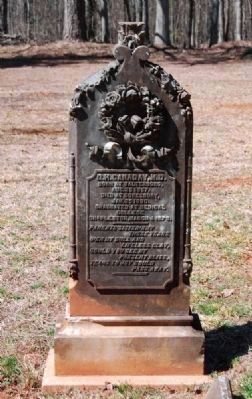
Photographed By Brian Scott, March 5, 2010
17. D.H. Canaday, M.D. (1857-1880) Tombstone
Aug. 25 1857
Died at Cokesbury
Jan. 25 1880
Graduated at Medical College
Charleston, March 4 1879
----------
Parents, sister, why these tears
Over my dull and lifeless clay,
Could you see my present bless,
Tears of joy would pass away.
Today, the only remnant of the community's existence lies down a forgotten path, which can hardly be considered a road. If you do decide to follow it, you'll come upon a clearing of antiquity -- a cemetery forgotten by nearly all except the spiders, which spin webs between the mossy, gray grave markers.
For such a historic place, Tabernacle community has become the definition of forgotten. The only clue to its past is a lone historical marker that reads, "TABERNACLE CEMETERY. 1,000 feet east is the Tabernacle Cemetery on the site of Tabernacle Methodist Church and Tabernacle Academy."
Moved to Higher Ground
According to Ted Morton, who is on the Cokesbury Historical and Recreational Commission, the community moved a mere two or three miles up the road toward higher ground -- a smart move that landed the people at the highest elevation between Augusta and Greenville.
"They moved houses, the church and the whole nine yards," Morton said. "But it wasn't practical to move a cemetery, so they left it there."
What they left behind was a relic, a burial ground for important war veterans, as the historical marker says.
"Buried here are Generals M.W. Gary & N.G. Evans and other Confederate veterans. From Tabernacle Academy organized in 1820 by Stephen Olin developed Mount Ariel and Cokesbury Conference School."
Churches in Ruins
According to a Southern Christian Advocate letter, written in 1838, by an A.H. Mitchell, the rector of/at Cokesbury, the society "was formed here by Humphries between 50 and 60 years ago (that would be 1778-88). Two houses of worship have mouldered into ruins, and already the third begins to look venerable with age."
According to Margaret Watson, author of Greenwood County Sketches, the Humphries mentioned above is Thomas Humphries, a Methodist preacher in South Carolina.
Watson wrote that the Tabernacle community "was becoming unpopular, and patrons decided to move the school. The abandoned school house was sold a long time after, and its timbers used in a neighborhood barn."
Her book also provides readers with a reason for the community's eventual ending, besides the fact they wanted to move to higher ground.
Watson wrote, "More people came into the area in the second decade of the 19th century. Some moved up from Cambridge, which was getting the reputation of being unhealthy. The same fact was to befall the Tabernacle community in another 10 years.
"Causes of malaria and other diseases were not understood, and the locality got the blame."
Residents soon left Tabernacle,
giving their home back over to the cherry birds that nest in the twisted tree limbs and the deer that playfully stir up the leaves of the woods.
Residents had a new home in mind, that beautiful point only a few miles up the road where they would soon establish the community of Cokesbury, the Daugherty Manual Labor School and the short lived Masonic Female College of South Carolina.
The famed and forgotten Tabernacle holds other stories. Each grave marker bears beginning and end date, a title page of a lifetime more or less past with the changing of the seasons.
Local historian Michael Edds said one grave holds an old Methodist pastor who served 46 years in the area. There are several 19th-century doctors.
Plots can be found with shortened distances between the stones -- the markers of children.
And though it would seem the community only houses the dead, Tabernacle still abounds in life. Birds chase each other through the tops of trees and squirrels scamper through the clearing; they haven't yet figured out Tabernacle is a fave haven.
— Submitted April 10, 2010, by Brian Scott of Anderson, South Carolina.
4. Society Aims to Inform About Local Historic Restoration, Preservation
by St. Claire Donaghy
The Greenwood Index-Journal
February
1, 2010
Growing up in Colleton County, Ernest Prewett often found himself traveling to nearby Charleston for goods and services and lessons in South Carolina history, but after moving to Greenwood in 1968, Prewett said he quickly learned not all of the Palmetto State’s history is tied to the Lowcountry.
“I’ve come to appreciate the history of the Upstate,” Prewett said. “It was the Upstate that more or less turned the tide of the Revolutionary War, but at one point in my life, I thought most of the history worth remembering happened in the Charleston area.”
Prewett is a former United Methodist minister, staff member with Piedmont Tech and president of the Greenwood County Historical Society, an organization with which he has been involved for a decade. For seven of those years, Prewett has served as president.
It’s through Prewett’s involvement with the historical society he has come to appreciate South Carolina’s upcountry history.
“I’m not a historian,” Prewett said. “But, as I have gotten older, I have developed genealogical interests and family history. One day, I went to a program at Star Fort (a national historic site from the Revolutionary War in Ninety Six.) And, in a day or two, I got a call, asking if I would join the board of the historical society and one thing led to another.”
Current
membership in the Greenwood County Historical Society is 75. Attendance at monthly meetings averages about 50 people. The society is led by a slate of officers and a board of directors.
Monthly meeting topics range from South Carolina coastal pirates to efforts of local homeowners to preserve older homes. Through meetings, the society seeks to inform about historic artifacts and structures of local interest that are in need of restoration and preservation.
“One of the biggest changes in recent years has been broadening representation on our board to include areas outside of the City of Greenwood,” Prewett said. “We now have representation from Ninety Six and Hodges and soon hope to from Ware Shoals.”
“Many who attend our meetings simply receive a personal invitation from someone involved with the society,” Prewett said. “Jo Wash, chairwoman of our membership committee, is evangelical in spreading the word about the society, but word of mouth is a factor, too.”
Among the society’s projects is a soon-to-be completed audio visual presentation about Old Greenwood Village, an area between the railroad tracks at East Cambridge Avenue, extending to West Cambridge Avenue.
“We employed a mass communications student from Clemson to do the filming and dubbing,” Prewett said. “The
star of the show is Betty “Beeka” Coleman, who is a past president of the society.”
In the presentation, Coleman talks informally about this portion of Greenwood previously known as Broadway or Church Street before being named Cambridge.
“Beeka recollects about people who used to live in the area and where shops and businesses used to be,” Prewett said.
The film was coordinated and funded by Carol Scales of Greenwood who is the secretary and treasurer for the historical society, Prewett said.
The society was also actively involved in getting a historic district designation for part of Greenwood.
A major current project is restoration of Tabernacle Cemetery, near Park Seed off S.C. 254.
“One of the interesting things about Tabernacle is that it predated Greenwood as a community,” Prewett said. Tabernacle dates to the late 1700s and lasted through the early 1800s, Prewett said.
Tabernacle had an academy, a church and homes. There are even historical references to a community library.
At some point during the 1800s, many in the community uprooted and moved en masse, to what is now the Cokesbury community, presumably Prewett said, to escape a widespread illness outbreak. Interestingly, Prewett said Cokesbury is thought to be one of this country’s earliest planned communities.
The only remaining physical artifact of the Tabernacle community is the cemetery, Prewett said.
“Through the years, the cemetery was very badly neglected and even vandalized,” Prewett said. “Nature has taken a toll, too.”
The historical society has taken it upon itself to organize restoration of Tabernacle, with the first step being getting it listed on the National Register of Historic Places, an effort headed by society member Missy Lowery.
“Now, we are working on restoring broken headstones, and we have contracted with Gaulden Monument Co. Inc, which is headquartered in Rock Hill but recently purchased Ethridge Monument Co. here. The company specializes in historic preservation.”
Tabernacle Cemetery restoration funding was raised through a campaign targeted at people with vested interests in Tabernacle, Prewett said.
One person asked to contribute was a Joyce Bowden, of Boston, who has ancestors buried there. Bowden said if the society raised $2,000 or more, she would give a funding match, which she did, Prewett said, noting the campaign brought in about $6,000.
“About a third of people we contacted by letter gave to the cause,” Prewett said. “For us, $6,000 is a substantial sum because our only other source for funding projects is annual membership dues.”
Dues
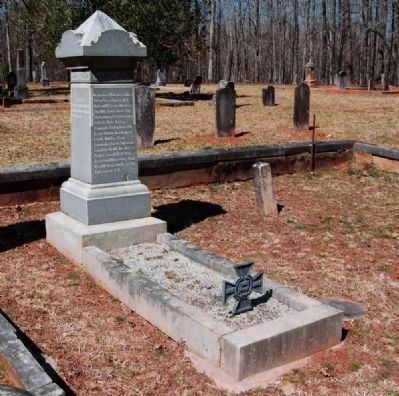
Photographed By Brian Scott, March 5, 2010
24. Martin Witherspoon Gary (1831-1881) Tombstone
[West Inscription]
Mar. 10, 1831
April 9, 1881
[South Inscription]
C.S.A.
Captain, Lieutenant Colonel,
Colonel Brigadier General,
Major General
[East Inscription]
Manassas, Elkshorn Landing, Seven Pines, Caines Mill, Malvern Hill, Second Manassas, Chanlilly, Boonesboro Gap, Sharpsburg, Fredericksburg, Suffolk, Wills Valley, Campbells Station, Knoxville, Beans Station, Malodaqueen Creek, Riddles Shop, Symmonia Church, Tilghmans Gate, Fusseils Mill, New Market Heights, Laurel Hill Church, Darbytown Williamsburg Road, Nine Mile Road, Amelia Spring, Appomattox Court House
April 9, 1881
Captain, Lieutenant Colonel,
Colonel Brigadier General,
Major General
[East Inscription]
Manassas, Elkshorn Landing, Seven Pines, Caines Mill, Malvern Hill, Second Manassas, Chanlilly, Boonesboro Gap, Sharpsburg, Fredericksburg, Suffolk, Wills Valley, Campbells Station, Knoxville, Beans Station, Malodaqueen Creek, Riddles Shop, Symmonia Church, Tilghmans Gate, Fusseils Mill, New Market Heights, Laurel Hill Church, Darbytown Williamsburg Road, Nine Mile Road, Amelia Spring, Appomattox Court House
Meetings are 3 p.m. on the last Sunday of the month in months that have five Sundays. The next scheduled meeting is Sunday at Cokesbury College, one local site on the National Historic Register.
Greenwood County has 20 sites listed on the national register and one pending, The Oaks, a historic home in Coronaca.
Greenwood County Historical Society is also a presenting organization during the March Peace Conference at Lander University, sponsored by People to People International. The society will share a presentation on historic sites in Greenwood County.
“We are always looking for volunteers to help us with restoration and preservation efforts,” Prewett said. “Our members are our major source of funding and our workforce in our historical education and preservation efforts.”
— Submitted April 10, 2010, by Brian Scott of Anderson, South Carolina.
5. A Rebel General Dead
The New York Times
April 10, 1881
the Southern Army and as a Lawyer
Augusta, Ga., April 9. -- Gen. Martin Witherspoon Gary died at 2 o'clock this morning at his home in Edgefield, S.C. He was 52 years old, and was ill two days from uraemia, which had been threatening him some time. He was born at Cokesbury, Abbeville County, S.C., but moved to Edgefield in early youth, because the Bar of that county, then the most brilliant and illustrious in the State, attracted the ambitious young men from all parts of the country. Wigfall, Wardlaw, Pettigrew, Chancellor Carroll, and others of wealth and reputation had ordained a sort of round-table in politics, law, and social life, and were growing exemplars of antebellum Southerners. Thus trained in this remarkable school of men, Mr. Gary grew up with the polish and prejudices of the traditional Southerner. He was, however, of strong character and native ability, and possessed more thrift and stamina than his colleagues. He was more of a self-made man than the typical Carolinian, and possessed a greater hold on the people at large. When the war broke out Mr. Gary entered the service as a Captain in Hampton's legion. He was afterward promoted to Lieutenant-Colonel. Upon the reorganization of the legion, he became a Brigadier-General of Cavalry, and was a dashing fighter in the army of Northern Virginia. He served from Manassas to the end, and when Lee surrendered, Gan. Gary did not give up hid sword, but turned over the command to a subordinate and cut his way home. Even up to the day of his death, he never had parole or pardon.
Resuming
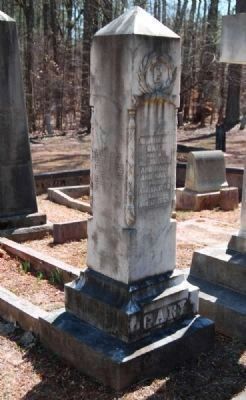
Photographed By Brian Scott, March 5, 2010
26. John Hilary Gary (1840-1863) Tombstone
[North Inscription]
Son of
Dr. Thomas B.
Mary Ann Gary
Born Aug. 17, 1840
Died Aug. 17, 1863
[East Inscription]
Brave as his own sword, he was wounded when in command of Battery Wagner and died in Charleston, S.C.
[North Inscription]Captain of
Artillery
C.S.A.
[West Inscription]Captain of the
South Carolina
College Cadets
Dr. Thomas B.
Mary Ann Gary
Born Aug. 17, 1840
Died Aug. 17, 1863
[East Inscription]
Brave as his own sword, he was wounded when in command of Battery Wagner and died in Charleston, S.C.
[North Inscription]
Artillery
C.S.A.
[West Inscription]
South Carolina
College Cadets
Gen. Gary was the strongest of friends and the hardest of haters. He was a very bold speaker, and dealt in invective, but friends say he was more conservative from common sense when action came than his extreme utterance would indicate when his tongue had play. He was generous and chivalrous by nature, and was good grit when emergency arose. He acted once as Gen. Butler's second, years ago, in the threatened difficulty with Pettibone, and himself challenged, some time ago, F.W. Dawson, of Charleston, editor of the News and Courier. Last year he had an open rupture, in a law case at Edgefield, with Gen. M.C. Butler, now Senator, but the matter blew over without the threatened affair of honor. Up to the last few years he had been a warm friend of Butler. Gen. Gary had amassed a large fortune. He was unmarried and was literary in tastes, being a devotee of the modern philosophies
of Huxley, Spencer, and others. Gen. Gary's disease, resulting from kidney affection, which killed Senator Carpenter and carried off so many public men, caused intense suffering during the last two days. When the Augusta physician reached him last evening he was almost pulseless and gradually sinking into the stupor which soon became the sleep of death. His younger brother, W.T. Gary, is a prominent lawyer in Augusta, now absent in Florida on account of ill-health. Gen. Gary's body will be interred tomorrow in Cokesbury, S.C., and the funeral will be attended by a large number of prominent men of Georgia and South Carolina. Be his followers in South Carolina he was known by the political sobriquet of the "Bald Eagle of Edgefield." He was tall, erect, very bald, and gray. He had small piercing gray eyes; was honest and unbending, and will be greatly missed.
— Submitted April 10, 2010, by Brian Scott of Anderson, South Carolina.
6. Martin Witherspoon Gary
The name of Martin Witherspoon Gary, lawyer, patriot, orator, Major-General in the Confederate Army, and leader in the fight to redeem South Carolina from negro and carpetbag misrule, will continue to shine with imperishable lustre as long as the Old Palmetto State stands; and every lover of the "Old South must love "Mart" Gary,
who as nearly as any man who ever lived, was typical of its ideals and aspirations.
Edgefield County, South Carolina, has long been a name that stood for that which was Southern; for in it and near it have lived some of the South's great men. This historic county was settled by the lest blood of the Old Dominion; for the Pendletons, Randolphs, Strothers, Butlers, Moores, Harrisons, Blands, Johnsons and many other noted Virginia families transplanted their blood into the scions of "old Edgefield's" stock. William H. Crawford, the great Georgia statesman, who narrowly missed the presidency, once lived in Edgefield County; the father of Herschel V. Johnson, the great Georgia orator, was reared in Edgefield County. Robert Toombs and Alexander Stephens, Ben Hill and Howell Cobb were born on the Georgia side, not a great way from the western border of this great county. Bonham and Travis, heroes of the Alamo, were Edgefield men. Indeed, this and other parts of upper South Carolina have been called "Little Virginia" from the stock and lineage of the people among whom were the ancestors of the subject of our sketch.
General Gary was a native of Abbeville County; graduated with honor at Harvard; read law under Chancellor Carroll, one of South Carolina's ablest judges; and finally settled in Edgefield for the practice of his profession.
I shall not speak of his
war record, though he was once promoted at the special instance of General Lee -- and no man needs any greater honor than that -- and rose to be a major-general in our "noble cause" still as dear to us as "the ruby drops that visit our hearts," good Americans as we now are; but I propose to view him as a lawyer and the leader in restoring the government of South Carolina to the people to whom of right it belonged.
While General Gary has been dead over forty years, his law office still stands -- a small frame building, rich in memories of the past. (Source: The Virginia Law Review 1922, by C.J. Ramage (1922), pg 253.
— Submitted April 10, 2010, by Brian Scott of Anderson, South Carolina.
7. Martin Witherspoon Gary
Born March 25, 1831 in Cokesbury, South Carolina. When the war started, he entered the Confederate Army as a captain, having previously been a lawyer and politician in South Carolina. Gary served as a colonel during most of the war, and he was promoted to brigadier general in May 1864. After the war he returned to politics. During the summer of 1879, Gary's health was poor and his long-standing neuralgia bothered him. He took six baths at Warm Springs and twenty-one at Hot Springs but noted improvement only in his complexion. In 1880 he spent
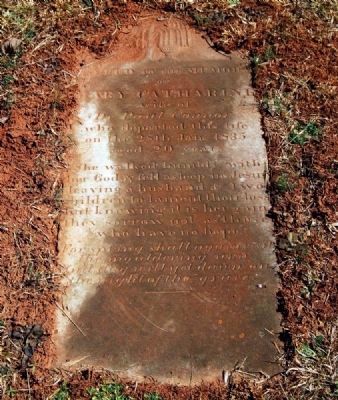
Photographed By Brian Scott, March 5, 2010
31. Mary Catherine Connor (1815-1835)
Tombstone
Tombstone
Dr. Paul Connor
who departed his life
on the 28th Jan 1835
aged 20 years.
She walked humbly with
her God & fell asleep in Jesus
leaving a husband & two
children to lament their loss
but knowing it is her gain
they sorrow not as those
who have no hope.
For spring shall again visit
the mouldering urn.
And day will yet dawn on
the right of the grave.
— Submitted April 10, 2010, by Brian Scott of Anderson, South Carolina.
8. Brig. Gen. Nathan George "Shanks" Evans
Brigadier General Nathan George Evans was born in Marion County, South Carolina, February 6, 1824, the third son of Thomas Evans, who married Jane Beverly Daniel, of Granville, North Carolina. He was graduated at Randolph-Macon College before he was eighteen, and at the United States Military Academy, which he entered by appointment of John C. Calhoun, in 1848. With a lieutenancy in the Second Dragoons, he was the first on duty at Fort Leavenworth, Kansas, whence he marched to the Rocky Mountains in 1849. In 1850 to 1853 he served in New Mexico, and began a famous career as an Indian fighter, which was continued in Texas and Indian Territory after his
promotion to Captain in 1856, in various combats with the hostile Comanches. At the battle of Wachita Village, October 1, 1858, his command defeated a large body of the Comanches, and he killed two of their noted chieftains in a hand-to-hand fight. For this he was voted a handsome sword by the legislature of South Carolina.
In 1860 he was married to a sister of Gen. M. W. Gary, of Abbeville County. He resigned from the old army in February, 1861, being then stationed in Texas, and taking farewell of his Colonel, Robert E. Lee, proceeded to Montgomery, and was commissioned major of the cavalry, C. S. A. Being assigned to duty as Adjutant-General of the South Carolina Army, he was present at the bombardment of Fort Sumter and was soon afterward promoted Colonel. Joining the army under General Beauregard at Manassas Junction, Virginia, he had a command on the field during the first encounter at Blackburn’s ford, and again in the great battle of July 21, 1861. At the opening of the latter engagement, his forces, consisting of the Fourth South Carolina regiment, a battalion of Louisiana volunteers, Terry’s squadron of cavalry, and a section of Latham’s battery, were stationed at the stone bridge, where he held the enemy in check in front, until he perceived in operation the flank movement which was the Federal plan of battle. Instantly, without waiting for orders, he threw
his little command in a new line, facing the enemy, and alone held him in check until reinforced by General Bee. With great intrepidity he and his men held their ground against great odds until the Confederate army could adapt itself to this unexpected attack. As remarked by a Northern historian: "Evans’ action was probably one of the best pieces of soldiership on either side during the campaign, but it seems to have received no special commendation from his superiors." General Beauregard commended his "dauntless conduct and imperturbable coolness," but it was not until after the fight at Leesburg that he was promoted. This latter engagement, known also as Ball’s Bluff, was fought in October, near the Potomac River, by his brigade mainly Mississippians, and a splendid victory was gained over largely superior numbers, with great loss to the enemy. His promotion to brigadier-general was made to date from this memorable affair, and South Carolina again, through her general assembly, gave him a vote of thanks and presented him with a gold medal. In 1862 he commanded a brigade consisting of the 17th, 18th, 22nd, and 23rd regiments, and Holcombe’s Legion, South Carolina troops, and was mentioned by General Longstreet among the officers most prominently distinguished in the battles of Second Manassas and Sharpsburg. In the latter fight he commanded his division. Thereafter his service
was mainly rendered in South Carolina. In 1863 he moved to the support of Johnston against Grant.
After the fall of Richmond, he accompanied President Davis as far as Cokesbury, South Carolina. A year later he engaged in business at Charleston, but was mainly occupied as a teacher at Midway, Alabama, until his death at that place, November 30, 1868. General Fitzhugh Lee has written of him: "’Shanks’ Evans, as he was called, was a graduate of the military academy, a native South Carolinian, served in the celebrated old Second Dragoons, and was a good type of the rip-roaring, scorn all-care element which so largely abounded in that regiment. Evans had the honor of opening the fight (First Manassas), we might say fired the first gun of the war." (Source: Confederate Military History, Vol. 5, pg 392.)
— Submitted April 10, 2010, by Brian Scott of Anderson, South Carolina.
Credits. This page was last revised on December 13, 2019. It was originally submitted on September 5, 2008, by Brian Scott of Anderson, South Carolina. This page has been viewed 4,653 times since then and 83 times this year. Photos: 1. submitted on April 9, 2010, by Brian Scott of Anderson, South Carolina. 2. submitted on September 5, 2008, by Brian Scott of Anderson, South Carolina. 3. submitted on April 9, 2010, by Brian Scott of Anderson, South Carolina. 4. submitted on September 5, 2008, by Brian Scott of Anderson, South Carolina. 5, 6. submitted on September 6, 2008, by Brian Scott of Anderson, South Carolina. 7. submitted on April 10, 2010, by Brian Scott of Anderson, South Carolina. 8, 9. submitted on April 9, 2010, by Brian Scott of Anderson, South Carolina. 10. submitted on April 10, 2010, by Brian Scott of Anderson, South Carolina. 11. submitted on September 6, 2008, by Brian Scott of Anderson, South Carolina. 12, 13, 14, 15. submitted on April 10, 2010, by Brian Scott of Anderson, South Carolina. 16, 17, 18, 19, 20, 21, 22. submitted on April 9, 2010, by Brian Scott of Anderson, South Carolina. 23. submitted on September 6, 2008, by Brian Scott of Anderson, South Carolina. 24, 25, 26. submitted on April 9, 2010, by Brian Scott of Anderson, South Carolina. 27. submitted on September 6, 2008, by Brian Scott of Anderson, South Carolina. 28, 29, 30, 31, 32, 33, 34, 35, 36, 37, 38, 39, 40, 41, 42, 43. submitted on April 10, 2010, by Brian Scott of Anderson, South Carolina. • Craig Swain was the editor who published this page.
